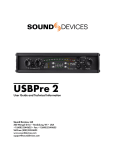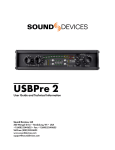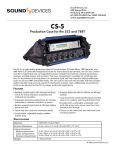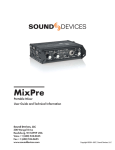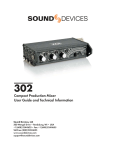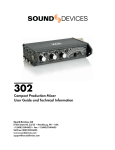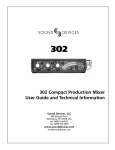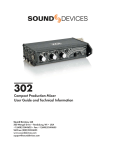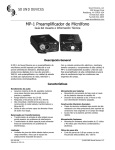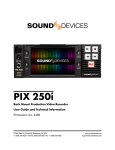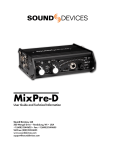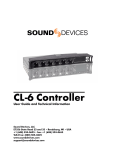Download Sound Devices USBPre 2 - User Guide and Technical
Transcript
USBPre 2 User Guide and Technical Information Sound Devices, LLC 300 Wengel Drive • Reedsburg, WI • USA +1 (608) 524-0625 • fax: +1 (608) 524-0655 Toll-Free: (800) 505-0625 www.sounddevices.com [email protected] USBPre 2 User Guide and Technical Information Table of Contents Table of Contents. . . . . . . . . . . . . . . . . . . . . . . . . . . . . .1 Computer System Requirements . . . . . . . . . . . . . . . . .2 Quick Start Guide . . . . . . . . . . . . . . . . . . . . . . . . . . . . .3 Sound Card Connection . . . . . . . . . . . . . . . . . . . . . . . . . . . . . .3 Front Panel Descriptions . . . . . . . . . . . . . . . . . . . . . . Input and Output Panel Descriptions . . . . . . . . . . . . Back Panel Descriptions . . . . . . . . . . . . . . . . . . . . . . . DIP Switch Options . . . . . . . . . . . . . . . . . . . . . . . . . . . Mac OS Installation and Connection . . . . . . . . . . . . . .5 .6 .6 .7 .8 OS X Audio / MIDI Setup . . . . . . . . . . . . . . . . . . . . . . . . . . . . .8 Adjusting Sample Rate in OS X . . . . . . . . . . . . . . . . . . . . . . . .8 Windows Installation and Connection. . . . . . . . . . . . .9 Windows 7 and Vista Sound Control Panel . . . . . . . . . . . . . . .9 Adjusting Sample Rate in Windows 7 and Vista. . . . . . . . . . .10 Windows XP Sound Control Panel . . . . . . . . . . . . . . . . . . . . .11 ASIO Driver . . . . . . . . . . . . . . . . . . . . . . . . . . . . . . . . .12 ASIO Driver Installation . . . . . . . . . . . . . . . . . . . . . . . . . . . . .13 Linux Installation and Connection . . . . . . . . . . . . . . .14 Inputs . . . . . . . . . . . . . . . . . . . . . . . . . . . . . . . . . . . . . .15 Input Source Selection . . . . . . . . . . . . . . . . . . . . . . . . . . . . . .15 Microphone Inputs . . . . . . . . . . . . . . . . . . . . . . . . . . . . . . . . .15 Phantom Power . . . . . . . . . . . . . . . . . . . . . . . . . . . . . . . . . . .15 Low-Cut Filter . . . . . . . . . . . . . . . . . . . . . . . . . . . . . . . . . . . .15 Input Pad . . . . . . . . . . . . . . . . . . . . . . . . . . . . . . . . . . . . . . . .15 Input Limiters . . . . . . . . . . . . . . . . . . . . . . . . . . . . . . . . . . . . .15 Line Inputs . . . . . . . . . . . . . . . . . . . . . . . . . . . . . . . . . . . . . . Aux Inputs . . . . . . . . . . . . . . . . . . . . . . . . . . . . . . . . . . . . . . Digital Inputs . . . . . . . . . . . . . . . . . . . . . . . . . . . . . . . . . . . . Input 2 Loop Source . . . . . . . . . . . . . . . . . . . . . . . . . . . . . . . .15 .16 .16 .16 Outputs and Monitoring . . . . . . . . . . . . . . . . . . . . . . .16 Headphone Output . . . . . . . . . . . . . . . . . . . . . . . . . . . . . . . . Main Outputs . . . . . . . . . . . . . . . . . . . . . . . . . . . . . . . . . . . . Digital Outputs . . . . . . . . . . . . . . . . . . . . . . . . . . . . . . . . . . . Metering . . . . . . . . . . . . . . . . . . . . . . . . . . . . . . . . . . . . . . . . .16 .17 .17 .17 Stand-Alone Mode . . . . . . . . . . . . . . . . . . . . . . . . . . . .17 Sample Rate . . . . . . . . . . . . . . . . . . . . . . . . . . . . . . . . . . . . .18 Locking Sample Rate to External Sources . . . . . . . .18 Setup Examples . . . . . . . . . . . . . . . . . . . . . . . . . . . . . .18 Test and Measurement. . . . . . . . . . . . . . . . . . . . . . . . . . . . . .18 High Performance Playback . . . . . . . . . . . . . . . . . . . . . . . . . .19 Block Diagram . . . . . . . . . . . . . . . . . . . . . . . . . . . . . . Specifications . . . . . . . . . . . . . . . . . . . . . . . . . . . . . . Warranty and Technical Support . . . . . . . . . . . . . . . CE Declaration of Conformity. . . . . . . . . . . . . . . . . . .20 .21 .22 .23 1 USBPre 2 User Guide and Technical Information Copyright and Release All rights reserved. No part of this publication may be reproduced, stored in a retrieval system, or transmitted in any form or by any means, electronic, mechanical, photocopying, recording, or otherwise, without the expressed written permission of SOUND DEVICES, LLC. SOUND DEVICES is not responsible for any use of this information. SOUND DEVICES, LLC shall not be liable to the purchaser of this product or third parties for damages, losses, costs, or expenses incurred by purchaser or third parties as a result of: accident, misuse, or abuse of this product or unauthorized modifications, repairs, or alterations to this product, or failure to strictly comply with SOUND DEVICES, LLC’s operating and installation instructions. Microsoft Windows is a registered trademark of Microsoft Corporation. Macintosh is a registered trademark of Apple, Inc. Other product and company names mentioned herein may be the trademarks of their respective owners. The sound waves logo is a registered trademark of Sound Devices, LLC. Computer System Requirements The requirements below outline the minimum configurations for systems using the USBPre 2. Software applications used with the USBPre 2 have their own requirements that may be in addition to the requirements of the USBPre 2. Consult your software’s documentation. Operating Systems Windows XP (SP3), Windows Vista, Windows 7 (both 32 and 64 bit) Macintosh OS 10.4 or greater Linux Kernel 2.6.0 or greater (Requires standard ALSA snd-usb-audio module) USB Audio Device Class Windows, Linux and Mac OS versions below 10.5.8 utilize USB Audio Device Class 1.0 drivers that will limit the USBPre 2 to sampling rates of 48 kHz and lower. Mac OS 10.5.8 and greater utilizes USB Audio Device Class 2.0 drivers that will allow the full range of sample rates that the USBPre 2 is capable of. USB Connection Full USB 1.1 or 2.0 compliance For Notebook Computer users: For proper operation of the USBPre, turn off all power management when using the USBPre for audio recording. Power management reduces processor speed, system bus speed, spins down hard disks, shuts down displays, or a combination of the above to reduce current consumption and extend battery run time. The change in state from active to power-saving mode can disrupt data on the USB bus and cause unintended dropouts. Sound Devices cannot guarantee that a given computer can be used satisfactorily with the USBPre 2 based exclusively on the fact that it meets the above requirements. 2 Features and specifications are subject to change. Visit www.sounddevices.com for the latest documentation. USBPre 2 User Guide and Technical Information Quick Start Guide Sound Card Connection 1. Attach the “A” plug of the (supplied) USB cable into an available “A” socket on the computer. Attach the “B” plug of the USB cable into the “B” socket on the USBPre 2. The USBPre 2’s meter LED’s will illuminate sequentially, indicating the USBPre 2 is connected and booting up properly. 2. Check to see that the operating system has recognized the USBPre 2 and designated the USBPre 2 as the default sound card. See Installation and Connection. 3. Connect an audio source. See Inputs. 4. Connect headphones or other monitoring equipment. Headphones Powered Monitors Powered monitors with balanced analog inputs can also be attached to the XLR outputs on the back panel of the USBPre 2. 5. Press the Input Select button repeatedly until the proper Input Source LED is illuminated for the input you will be recording. 3 USBPre 2 User Guide and Technical Information Input 1 set to Mic (XLR) Input 2 set to Line (1/4” TRS) 4 6. If the PRE Meter Source LED is not illuminated, press the Meter Source button to change the meter source to display input levels. 7. For analog input sources, adjust the Input Gain Control corresponding to the input being recorded. Input Gain Controls do not affect digital input levels. The meters will show the audio level of the input. 8. Launch an audio application on the computer. Make certain that the USBPre 2 is selected as the input and output device in the application’s preferences. Consult the applications documentation for further information. Features and specifications are subject to change. Visit www.sounddevices.com for the latest documentation. USBPre 2 User Guide and Technical Information Front Panel Descriptions 2 1 4 3 5 6 1) Input Gain Controls Adjusts input gain. Gain is minimized (not turned off) at full counter-clockwise setting. Gain control only affects analog input sources. 2) Low-Cut LED Illuminates when low-cut filter is engaged on either mic input. See DIP Switch Options. 3) 15 dB pad LED Illuminates when 15 dB pad is engaged on either mic input. See DIP Switch Options. 4) 48V Phantom Power LED Illuminates when phantom power is engaged on either mic input. See DIP Switch Options. 5) Input 1 Split LED Illuminates when Input 1 Split is active. See DIP Switch Options. 6) Input Select Buttons and Input Source LEDs Selects between the available input types. Input Source LED to the right will illuminate to indicate which source is currently active. 7) Meter 23-segment LED meter. Calibrated in dBFS, with peak + VU ballistics. 8) Meter Source Button Switches meter source between input or output signal. LED illuminates to indicate current selection. 8 7 10 9 12 11 13 9) Headphone Mono Button and LED Toggles between mono and stereo monitoring of analog input audio in headphones; especially useful when multitrack recording and recording from one input. LED illuminates when Mono is active. This function can be configured to affect PC Audio as well. See DIP Switch Options. 10) Limiter LEDs Illuminates amber when limiting is occuring. 11) Monitor Mix Control Selects the signal source to be monitored in the headphones between analog source audio (PRE) and computer audio (PC). Listening to PRE audio allows zero latency monitoring of analog input sources. The center position mixes monitoring of both source and computer audio. The signal at the AUX Output and balanced XLR Output is unaffected by this control. NOTE: S/PDIF digital inputs cannot be monitored in the headphones. S/PDIF signal can only be monitored after being processed by the computer. 12) Output Gain Control (Small Knob) Adjusts gain of AUX Output and balanced XLR output. Can be configured to adjust headphone gain. See DIP Switch Options. 13) Headphone Volume Control (Big Knob) Adjusts headphone gain. Can be configured to adjust XLR and AUX output levels. See DIP Switch Options. 5 USBPre 2 User Guide and Technical Information Input and Output Panel Descriptions 1 2 4 3 1) Mic Inputs Active-balanced XLR inputs accept lowimpedance microphone-level signals. 5 6 7 5) AUX Output Audio output to feed powered loudspeakers, CD Recorders, Camcorders, or Portable DVD Recorders. RCA connectors. Computer audio only. 2) Line Inputs Accepts balanced line-level signals. 6) S/PDIF (Coaxial) Input and Output Coaxial digital input and output connectors. Input is selected via the front panel input selection switch. 3) AUX Inputs Accepts consumer-level inputs such as CD Players, Camcorders, Portable DVD Players, and Mini-jack from computers via RCA connectors. 7) USB Port USB B-type connector for interconnection with the computer; provides all data and power to the USBPre 2 via USB bus powering. USB 1.1 and 2.0 compliant. 4) Headphone Outputs 3.5 mm and ¼-inch TRS stereo heaphone outputs can drive low-impedance headphones. NOTE: The USBPre can drive headphones to dangerously loud levels - take caution when setting the headphone level. Back Panel Descriptions 1 1) Balanced XLR Outputs Active-balanced analog outputs. Mic / Line switchable. See DIP Switch Options. 2 3 3) DIP Switches DIP Switches to configure various aspects of the USBPre 2. 2) S/PDIF (Optical) Input and Output Optical digital (TOSLINK) input and output connectors. 6 Features and specifications are subject to change. Visit www.sounddevices.com for the latest documentation. USBPre 2 User Guide and Technical Information DIP Switch Options The DIP switches on the back panel of the USBPre 2 can control various features. To adjust an individual switch, carefully move the switch with a slender tool. 7 B Settings STAND ALONE SAMPLE RATE OFF 6 8 9 10 ON PHONES OFF 5 ON AUTO 4 OUTPUT 3 MANUAL LINE INPUT ONLY 2 ALL LINE 1 MIC 1 MIC ON 2 OFF ON 3 OFF ON ON 4 OFF ON 5 OFF ON 6 OFF ON 7 OFF 8 OFF ON 9 OFF 10 OFF ON In the following descriptions, “Up” refers to the direction opposite the numbering on the switch casings. 48K 192K 176.4K 96K 88.2K 44.1K 32K 16K A Settings • 48 Volt Phantom Power (9 and 10) Up position engages 48 Volt phantom power on balanced microphone inputs. Required for condenser microphones. See Inputs Section. • Low-Cut Filter (7 and 8) Up position engages low-cut filter on balanced microphone inputs. -3 dB at 80 Hz. 12 dB per octave. See Inputs Section. • Limiter (5 and 6) Up position engages limiters on balanced microphone inputs. Attenuates signal above -4 dBFS. See Inputs Section. • 15 dB Pad (3 and 4) Up position reduces gain by 15 dB on balanced microphone inputs. Useful for sensitive microphones or very loud program material. See Inputs Section. • Dual Mono (1) Up position disables input 2 and routes input 1 signal to both tracks. • Balanced Output Level (1 and 2) Determines level of balanced XLR outputs. Up position: Line level (0 dBu). Down position: Mic level. (-40 dBu). See Outputs and Monitoring. • HP Mono Function (3) Adjusts what signals are summed when HP MONO is active. Up position: Input signals only. Down position: Input signals and output audio from the computer. See Ouputs and Monitoring. • Meter PRE/PC (4) Adjusts whether or not the meter source switches automatically to PC metering when computer audio is present. Up position: Automatic. Down position: Manual. See Ouputs and Monitoring. • HP / Output Knob (5) Adjusts which knob controls headphone gain and which knob controls main output gain. Up position: Big Knob controls headphone gain and Small Knob controls main output gain. Down position: Big Knob controls main output gain and Small Knob controls headphone gain. • Headphone Signal to Outputs (6) Up position: Only computer audio is sent to outputs. Down position: Main (analog) output source is the same as headphone signal source and affected by Monitor Mix Control. Note: In Stand-alone mode, input signal is always routed to the outputs and this setting has no effect. • Input Select Lock (7) Up position: Input Select Buttons function normally. Down position: Input Select Buttons are disabled and input source selection is locked. • Stand-Alone Sample Rate (8, 9, and 10) Sets the operating sample rate when in StandAlone mode according to the associated diagram. See Stand-Alone mode. In Soundcard Mode, sample rate is determined by the computer. See Installation and Connection. 7 USBPre 2 User Guide and Technical Information Mac OS Installation and Connection Before connecting the USBPre 2, quit all open applications that use audio. An application that is running when the USBPre 2 is connected may not recognize the USBPre 2 until the application is restarted. When connecting the USBPre 2 to a computer with OS X 10.5 or earlier installed, hold down the Input 1 Source Select button while pluggin in the USBPre 2. This will cause the USBPre 2 to initialize in USB Fullspeed mode, which is required for OS X 10.5 and earlier. Screen shots show Mac OS 10.6 OS X Audio / MIDI Setup 1. Follow Applications> Utilities> Audio MIDI Setup to open the Audio MIDI Setup dialog. 2. OS X 10.6 and later: Highlight the USBPre 2 item, click the button with the gear icon and select Use this device for sound output. Click the button with the gear icon again and select Use this device for sound input. OS X 10.5 and earlier: Ensure that the USBPre 2 is selected for both the Default Input dropdown menu and the Default Output dropdown menu in the System Settings section. Adjusting Sample Rate in OS X 1. 8 Follow Applications> Utilities> Audio MIDI Setup to open the Audio MIDI Setup dialog. Features and specifications are subject to change. Visit www.sounddevices.com for the latest documentation. USBPre 2 User Guide and Technical Information 2. OS X 10.6 and later: Highlight the USBPre 2 item and adjust the sample rate and bit depth from the drop-down box labeled Format. OS X 10.5 and earlier: Select the USBPre 2 from the Properties For dropdown menu, then set the sample rate, channel count, and bit depth as desired from the dropdown menus in the Audio Input section and the Audio Output section. Windows Installation and Connection The USBPre 2 is an Audio Device Class USB standard peripheral. No proprietary drivers are required to operate the USBPre 2 under Windows. The first time the USBPre 2 is plugged in, Windows will install standard USB Audio Device Class drivers automatically. Before connecting the USBPre 2, quit all open applications that use audio. An application that is running when the USBPre 2 is connected may not recognize the USBPre 2 until the application is restarted. Windows 7 and Vista Sound Control Panel 1. Follow Start> Control Panel> Sound. 9 USBPre 2 User Guide and Technical Information 2. Click the Playback tab. 3. Click to select the item labeled “USBPre2” in the list of devices. 4. Click the Set Default button. A green check mark icon will appear next the the USBPre 2 entry and the phrase “Default Device” will appear below the entry, indicating that the USBPre 2 is now the default playback device. 5. Click the Recording tab and repeat and repeat steps 3 and 4 to make the USBPre 2 the default recording device. Adjusting Sample Rate in Windows 7 and Vista 10 1. Follow Start> Control Panel> Sound. 2. Click the Playback tab. Highlight (Single click) the entry labeled “USBPre2” and then Click the Properties button. Features and specifications are subject to change. Visit www.sounddevices.com for the latest documentation. USBPre 2 User Guide and Technical Information 3. Click the Advanced tab. Select the desired bit depth and sample rate from the dropdown menu. Windows XP Sound Control Panel 1. Follow Start> Control Panel. The control panel view will be be in either “Classic view” or “Category view”. 2. If category view is enabled, click Sounds, Speech, and Audio Devices, then click Sounds and Audio Devices. Skip to step number 4. 11 USBPre 2 User Guide and Technical Information 3. If classic view is enabled, click Sounds and Audio Devices. 4. Click the Audio tab. Select the USBPre 2 from the Default device dropdown menu in the Sound playback section. Select the USBPre 2 from the Default device dropdown menu in the Sound recording section. ASIO Driver The ASIO driver for the USBPre 2 allows for low-latency operation and sample rates up to 192 KHz on Windows computers. The ASIO drivers include a WDM counterpart, so applications that use standard WDM for playback and recording will still operate as normal after installation. After installation, the USBPre 2 will be available as an ASIO device in applications that utilize ASIO. 12 Features and specifications are subject to change. Visit www.sounddevices.com for the latest documentation. USBPre 2 User Guide and Technical Information ASIO Driver Installation 5. Determine if your version of Windows is 32 or 64 bit by viewing the System information window. This window can be accessed by right-clicking Computer (located in the Start Menu or on the Desktop) and selecting Properties. It can also be accessed by the shortcut Windows Key + Pause/Break key. The operating system type will be listed in the “System” section of this window. 6. Proceed to http://www.sounddevices/download/usbpre2-asio.htm and download the appropriate driver based on your system type. 7. Plug the USBPre 2 into the computer with a USB cable. 8. Locate the downloaded file and double-click it to run the installer program. 9. The welcome window will appear. Click OK. 10. The WinZip self extractor window will appear. Click Setup. 11. When the extractor is completed, the language selection window will appear. Select your prefered language and click OK. 12. A window will appear offering the uption to install, uninstall, or exit. Click Install the Driver. 13 USBPre 2 User Guide and Technical Information 13. The installation process will begin. If the USBre 2 is not plugged in, the installer will request that you do so. 14. The final window will appear. Click Exit. 15. Unplug the USB cable from the USBPre 2. 16. Plug the USB cable back in to the USBPre 2. Uninstalling ASIO Driver 1. Open the Programs and Features section (Windows 7 and Vista) or Add / Remove Programs (Windows XP) in the Control Panel (located in the Start menu). 2. Locate the item in the list that is titled USBPre 2.0 USB ASIO Driver, highlight it, then click Uninstall. This is all that is required to uninstall the driver from Windows XP and Vista. Further steps are required to completely remove the driver from Windows 7. The following steps are for Windows 7 only. 14 3. Restart the computer. 4. Right-click Computer (located in the Start Menu or on the Desktop) and select Properties. Features and specifications are subject to change. Visit www.sounddevices.com for the latest documentation. USBPre 2 User Guide and Technical Information 5. On the left sidebar of the System window, click Device Manager to open the Device Manager window. 6. Expand the Sound, video, and game controllers section. 7. Right-click the entry in this section titled USBPre 2.0 Audio 1.0.0 and select Uninstall. 8. Ensure that the checkbox titled Delete the driver software for this device is checked, then click OK. 9. In the Device Manager, expand the section titled Universal Serial Bus controllers and repeat steps 7 and 8 on the entry in this section titled USBPre 2.0 Audio 1.0.0. 15 USBPre 2 User Guide and Technical Information Linux Installation and Connection The USBPre 2 is an Audio Device Class USB standard peripheral. No proprietary drivers are required to operate the USBPre 2 under Linux. The first time the USBPre 2 is plugged in, Linux will enable standard USB Audio Device Class drivers automatically (if necesarry). Current Linux audio drivers only support USB audio devices at “Full speed” USB rates. The USBPre 2 must be forced into Full Speed mode by holding down the Input 1 Source button when plugging in the USB cable to the USBPre 2. Before connecting the USBPre 2, quit all open applications that use audio. An application that is running when the USBPre 2 is connected may not recognize the USBPre 2 until the application is restarted. Inputs Input Source Selection The USBPre 2 has two available input channels. The source for each input is independently selected using the Input Select Buttons on the front panel. The selected source is indicated by an illuminated LED next to the respective Input Select Button. The Input Select Buttons can be locked to prevent accidental switching of the input sources. See DIP Switch Options. Microphone Inputs Phantom Power The USBPre 2 provides 48-volt phantom power for condenser microphones connected to the XLR inputs. Phantom power can be engaged independently for each input. See DIP Switch Options. Condenser microphones that can operate on phantom voltages from 11-52 volts will function properly with 48-volt phantom. Dynamic microphones typically do not require phantom power. A properly connected balanced, dynamic microphone is not affected by the presence of phantom power nor will it draw any current. However, it is good practice to turn phantom power off when not needed. Poor or incorrectly wired microphone cable can cause audible artifacts in microphone signals. Some wireless receivers outputs are adversely affected by the presence of phantom power, therefore, consult the wireless receiver documentation. Low-Cut Filter The low-cut filter attenuates low frequency signals. This is useful in conditions where low frequency signal is causing overload before the desired gain is reached (windy environments or handheld microphones, for example). Input Pad With some combinations of microphone sensitivity and sound pressure levels, the microphone input of the USBPre 2 can become overloaded even when the input gain is at its lowest level. A 15 dB pad can be engaged on the microphone input to reduce its sensitivity. See DIP Switch Options. Input Limiters In environments where high sound pressure levels may occur unexpectedly, input limiting prevents distortion by attenuating signals that surpass the input threshold level. In normal operation with properly set input levels, the threshold of an input limiter is rarely reached. Signals below the threshold are not affected by the limiter. Limiters can be engaged on each microphone input independently. See DIP Switch Options. The amber LIM LED’s on the right side of the meters will illuminate to indicate when limiting is occurring. 16 Features and specifications are subject to change. Visit www.sounddevices.com for the latest documentation. USBPre 2 User Guide and Technical Information Line Inputs The Line Inputs use balanced, quarter-inch connectors and accept +4 dBu analog signal (sometimes referred to as “Professional” line level). Wiring is tip: signal (+), ring: signal (-), and sleeve: ground. Aux Inputs The Aux Inputs use unbalanced, RCA connectors and accept -10 dBu analog signal (sometimes referred to as “Consumer” line level). This input is designed for signal from CD players, camcorders, portable DVD players, and other similar devices. Signal output from turntables without built-in phono preamplifiers is too weak for the USBPre 2’s Aux Inputs. A separate phono preamplifier may be required depending on the design of the turntable. Digital Inputs Digital signal in the S/PDIF format can be input to either the coaxial RCA connector or the optical TOSLINK connector. If signal is present at both the optical and coaxial input, the signal from the optical input takes precedence. Sample rates below 32 kHz are not supported on the digital connections. The optical connections do not support the 192 kHz sampling rate. Input 2 Loop Source Input 2 has an additional source labeled LOOP. This input source does not correspond to any physical connections on the USBPre 2. When LOOP is selected, input 2’s source is derived from the left channel of the computer audio signal (post digital-to-analog conversion). The input 2 Gain Control affects signal The Output Gain Control does not affect the level of the signal going in to input 2. The LOOP source is useful for test and measurement applications where a reference signal is required to be routed back to an input. Outputs and Monitoring Headphone Output The USBPre 2 has a high current headphone amplifier for monitoring analog input audio, computer audio, or a mix of both. The Headphone Volume Control adjusts the level of the signal to the headphones. The Headphone Volume Control knob and the Output Gain Control knob can be swapped with the back panel DIP Switches. See DIP Switch Options. Caution: The USBPre 2 is capable of driving headphones to dangerously high levels. Be aware of headphone level controls at all times. Use the Monitor Mix Control on the front panel to adjust the mix between direct audio from the inputs (fully counter-clockwise) and output audio from the computer (fully clockwise). The signal for input audio is derived from the inputs before analog-to-digital conversion. 17 USBPre 2 User Guide and Technical Information Headphone Mono mode sums the input signals from both inputs into a mono mix for the headphones. To toggle Headphone Mono mode, push the Headphone Mono button on the front panel. The Headphone Mono LED will illuminate when Headphone Mono mode is active. Optionally, the stereo signal from the computer can also be summed when Headphone Mono mode is engaged. See DIP Switch Options. Main Outputs Signal level at the balanced XLR outputs and unbalanced AUX outputs is adjusted with the Output Gain Control. The signal source for the outputs is the output audio from the computer. This source can be changed to the same source as the headphone output with the back panel DIP Switches. The balanced XLR outputs are set to line level by default and can be set to mic level with the back panel DIP switches. See DIP Switch Options. The Windows Volume Control (controlled with the “speaker” icon in the system tray) and the Mac volume control affect the level of the computer’s output audio before it reaches the USBPre. It is generally best practice to set the volume control to 100% and make adjustments to the output level with the USBPre 2’s Output Gain Control. Digital Outputs When the USBPre 2 is used as a computer audio interface, the sample rate of the digital outputs (Coaxial S/PDIF and optical TOSLINK) is determined by the application settings on the computer. In Stand-alone mode, the sample rate is determined by the position of the back panel DIP switches. Optical (TOSLINK) outputs are inoperable at 192 kHz sample rate. Metering The USBPre 2 features a 23-segment, 2 channel LED meter. The meter displays both the peak level of source audio and average (VU) levels simultaneously. 0 dB on the meter is calibrated to 0 dBFS signal coming from the computer. The current source signal for the meter is indicated by an illuminated LED next the Meter Source Button. The meter source can be toggled by pushing the Meter Source Button. When the meter source is set to PC the meter displays the audio level for signal coming from the computer. In this mode, the top row of the meter displays the left channel level and the bottom row displays the right channel level. When the meter source is set to PRE, the meter displays the audio level for signal at the active inputs.In this mode, the top row of the meter displays the level for the selected input source on channel one and the bottom row displays the level for the selected input source on channel 2. The meter source switches from PRE to PC automatically when signal is output from the computer. This behavior can be defeated so that the source is switched manually. See DIP Switch Options. Stand-Alone Mode In Stand-Alone mode, the USBPre 2 operates as a microphone preamplifier with both digital and analog outputs. It can also accept digital signals and output analog audio. The USBPre 2 will automatically enter stand-alone mode when connected to a USB jack supplying USB power (5V, 500 mA max) but is not associated with a running operating system (For example, a powered USB hub that is 18 Features and specifications are subject to change. Visit www.sounddevices.com for the latest documentation. USBPre 2 User Guide and Technical Information not attached to a computer). The USBPre 2 can be forced into Stand-alone mode when connected to a computer supplying USB power by holding down the Meter Source button when attaching the USB cable. In Stand-Alone mode all front panel controls perform the same functions as when the USBPre 2 is in Interface mode, except that the Meter Source button is disabled and the meter mode is locked to PRE. Since there is no reference clock from the computer, the operating sample rate is set using the back panel DIP Switches. See DIP Switch Options. Sample Rate In Stand-alone mode, the sample clock is generated by the USBPre 2’s internal sample clock generator, and the Sample rate is set by adjusting the DIP switches on the back panel of the USBPre 2. See DIP Switch Options. This will affect the internal sample rate of the USBPre 2 as well as the sample rate output from the digital outputs. Sample rates below 32 kHz are not supported on the coaxial or optical (TOSLINK) digital interconnections. 192 kHz sampling rate is not supported on the TOSLINK interconnections. In Interface mode, the USBPre 2 operates at the sample rate set from the host operating system and the DIP switches related to sample rate are ignored. It is further possible to change the sampling rate of the USBPre 2 within some applications’ audio preferences. In Windows XP there is no global sample setting, and the sample rate must be set by the application in use. Locking Sample Rate to External Sources The sample rate of the USBPre 2 can be locked to the sample rate of an external S/PDIF signal. When a digital signal is connected to either the coaxial or optical input, the S/PDIF Input Source LED will illuminate to indicate that the USBPre 2 is locked to the sample rate of the incoming digital signal. The S/PDIF Input Source LED’s will flash for 30 seconds when the signal is removed or turned off. To make a digital recording with the computer at a locked sample rate, be certain that the incoming digital signal is valid (solid S/PDIF Input Source LED’s) and that the software driver is set to the same sample rate as that of the incoming digital signal (See Installation and Connection section for your operating system). If the USBPre 2 senses a discrepency in the incoming digital signal such as a clocking error, the Meter Source LED’s will flash until the Meter Source button is pushed. Setup Examples Test and Measurement The high quality preamplifiers and portability of the USBPre 2 make it a perfect interface for test and measurement applications. A requirement for measuring a transfer function is the ability to monitor the output reference signal from the computer. The LOOP source of input 2 enables a copy of the computer audio left channel to be internally routed to input 2. This allows reference signal to be sent back into the measurement application without additional cabling. The USBPre 2 supports native sample rates below 44.1 kHz to provide better FFT resolution for lowfrequency audio measurements. 19 USBPre 2 User Guide and Technical Information To PA Input 1 set to Mic (XLR) Input 2 set to Loop High Performance Playback The USBPre 2 can provide high-quality audio output from a computer to reference monitors in a studio control room or a home stereo system. Depending on the connectivity of the monitors, the balanced XLR outputs, unbalanced RCA outputs, or digital S/PDIF outputs can be used to send computer audio to the monitors. Monitors LEFT RIGHT Power amplifier input Power amplifier 20 Features and specifications are subject to change. Visit www.sounddevices.com for the latest documentation. USBPre 2 User Guide and Technical Information Block Diagram 21 USBPre 2 User Guide and Technical Information Specifications 22 Frequency Response (reference 1 kHz tone. 192 kHz sample rate) Any input to PC recording: • 10 Hz - 40 kHz, +/- 0.5 dB • -3 dB at 65 kHz THD+N (22 Hz - 22 kHz measurement bandwidth) • 0.05% max (any input to PC recording, gain control at min, input driven to -6 dBFS) • 0.009% max (AUX output, 0 dB V output, 100k ohm load) • 0.05% max (HEADPHONES output, 2 V rms output, 600 ohm load) E.I.N. (MIC inputs) • -127 dBu min (22 Hz - 22 kHz bandwidth, 150 ohm source, gain control fully clockwise, 15 dB pad out) Input Clipping Level (1% THD) • Mic: -10 dBu (0.25 V RMS) • Mic (15 dB pad): +4 dBu (0.78 V RMS) • Line: +28 dBu (19.45 V rms) • Aux: +9 dBu (2.18 V rms) Input Sensitivity (typical, for 0 dBFS) • Mic: -10 dBu min, -60 dBu max • Mic (15 dB pad): +4 dBu min, -45 dBu max • Line: +29 dBu min, +10 dBu max • Aux: +12 dBu min, -7 dBu max. Input Impedance (actual) • Mic: 4k ohm, active-balanced • Line: 60k ohm, active-balanced • Aux: 80k ohm Input Limiter Threshold • Mic: -4 dBFS Low Cut • Mic: -3 dB at 80 Hz. 12 dB per octave Output Clipping Level (1% THD, PC-controlled output levels at max) • Balanced XLR: +18 dBu with 100k ohm load • Aux: +8 dBu (2.0 V rms) with 100k ohm load • Headphones: +11 dBu (2.75 V rms) with 600 ohm load Output Impedance • Balanced XLR (Line level): 500 ohms • Balanced XLR (Mic level): 5 ohms • Aux: 660 ohms S/PDIF Digital • 24 or 16 bit input A/D Converter • 24-bit resolution. 114 dB typical dynamic range (22 Hz - 22 kHz bandwidth, A-weighted) D/A Converter • 24-bit resolution. 112 dB typical dynamic range (22 Hz - 22 kHz bandwidth, A-weighted) Analog Gain • Mic: 80 dB max • Mic (15 dB pad): 65 dB max • Line: 30 dB max • Aux: 13 dB max Sample Rates / Bit Depths • Recording: 8, 16, or 24-bit at 8, 16, 32, 44.1, 48, 96, or 192 kHz • Playback: 24-bit at 8, 16, 32, 44.1, 48, 96, or 192 kHz Master Clock • Crystal based, low jitter Metering • 2 x 23 segments, 44 dB total range, peak ballistics. 0 dB on meter = 0 dBFS (0 dB referenced to full scale digital) Phantom Power • 48 V through 6.8k ohm resistors. Each mic input will supply 10 mA Powering • USB bus powered. 5 V (+/- 10%), 500 mA max current from USB port (USBPre 2 will not function if connected through a passive USB connection or hub) Dimensions (unpackaged) • 4.3 cm x 18 cm x 10 cm (H x W x D) PC source to AUX or XLR output: • 10 Hz - 40 kHz, +/- 0.5 dB • -3 dB at 65 kHz • 1.7 in. x 7.25 in. x 4.25 in. (H x W x D) Weight • 0.5 kg • 1.13 lbs. Certifications • Meets FCC Part 15 Class B • Complies with the Requirements of European Directive 89/336/EEC Included Accessories • USB Cable • Rubber Feet Features and specifications are subject to change. Visit www.sounddevices.com for the latest documentation. USBPre 2 User Guide and Technical Information Warranty and Technical Support Warranty & Service Sound Devices, LLC warrants the USBPre 2 against defects in materials and workmanship for a period of ONE (1) year from date of original retail purchase. This is a non-transferable warranty that extends only to the original purchaser. Sound Devices, LLC will repair or replace the product at its discretion at no charge. Warranty claims due to severe service conditions will be addressed on an individual basis. THE WARRANTY AND REMEDIES SET FORTH ABOVE ARE EXCLUSIVE. SOUND DEVICES, LLC DISCLAIMS ALL OTHER WARRANTIES, EXPRESS OR IMPLIED, INCLUDING WARRANTIES OF MERCHANTABILITY AND FITNESS FOR A PARTICULAR PURPOSE. SOUND DEVICES, LLC IS NOT RESPONSIBLE FOR SPECIAL, INCIDENTAL, OR CONSEQUENTIAL DAMAGES ARISING FROM ANY BREACH OF WARRANTY OR UNDER ANY OTHER LEGAL THEORY. Because some jurisdictions do not permit the exclusion or limitations set forth above, they may not apply in all cases. For all service, including warranty repair, please contact Sound Devices for an RMA (return merchandise authorization) before sending your unit in for repair. Product returned without an RMA number may experience delays in repair. When sending a unit for repair, please do not include accessories, including carry cases, cables, or adapters unless instructed by Sound Devices. Sound Devices, LLC Service Repair RMA #XXXXX 300 Wengel Drive Reedsburg, WI 53959 USA telephone: (608) 524-0625 Technical Support / Bug Reports For technical support and bug reporting on all Sound Devices products contact: Sound Devices, LLC E-mail: [email protected] web: www.sounddevices.com/support Telephone: +1 (608) 524-0625 / Toll-Free in the U.S.A.: (800) 505-0625 Fax: +1 (608) 524-0655 23 USBPre 2 User Guide and Technical Information CE Declaration of Conformity According to ISO/IEC Guide 22 Sound Devices, LLC 300 Wengel Drive Reedsburg, WI 53959 USA declares that the product, USBPre 2 Portable Computer Audio Interface is in conformity with and passes: EN55103-1, 1997 EMC-product family standard for audio, video, audio-visual and entertainment lighting control apparatus for professional use. Part 1: Emissions EN55103-2, 1997 EMC-product family standard for audio, video, audio-visual and entertainment lighting control apparatus for professional use. Part 2: Immunity EN55103-1 Phenomena 2, 3, 1997 Magnetic emissions at 1 meter 50 Hz – 50 kHz EN55103-2 Phenomena 3, 1997 Magnetic immunity 50 Hz to 10 kHz EN61000-4-2 (2001)/ IEC61000-4-2 (2001) ESD, ±4 kV contact, ±8 kV air discharge EN61000-4-3 (2001)/ IEC1000-4-3 (2001) Radiated RF immunity, 10 V/m, 80% 1 kHz amplitude modulation EN61000-4-4 (2001)/ IEC61000-4-4 (2001) AC power ports: EFT Burst, I/O lines, ±0.25 kV to ±1.0 kV, power line ±0.5 kB – ±1 kV EN61000-4-4 (2001)/ IEC61000-4-4 (2001) EFT Burst, I/O lines, ±0.25 kV to ±1.0 kV, power line ±0.5 kB – ±1 kV EN61000-4-5 (2001)/ IEC61000-4-5 (2001) Surge ±1 kV differential mode (line-to-line), ±2 kV common mode (line-to-ground) EN61000-4-6 (2001)/ IEC61000-4-6 (2001) Conducted RF immunity, 3 V, 80% @1 kHz amplitude modulation IEC61000-4-11(2001) Voltage dips and short interruptions at test voltage level: 0% V unominal @ 70% V unominal @ 25 period Tested by L. S. Compliance, Inc. Cedarburg, Wisconsin July 14, 2010 Matthew Anderson Director of Engineering Sound Devices, LLC 24 Features and specifications are subject to change. Visit www.sounddevices.com for the latest documentation. USBPre 2 User Guide and Technical Information 25 USBPre 2 Rev. 1.0b - Printed in the U.S.A.



























